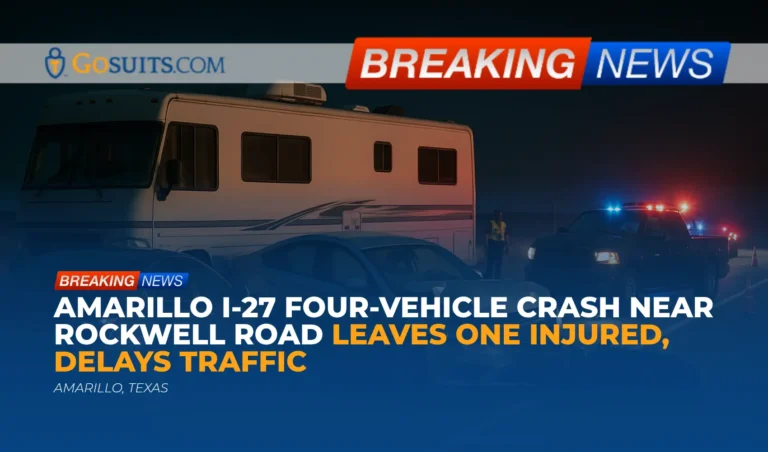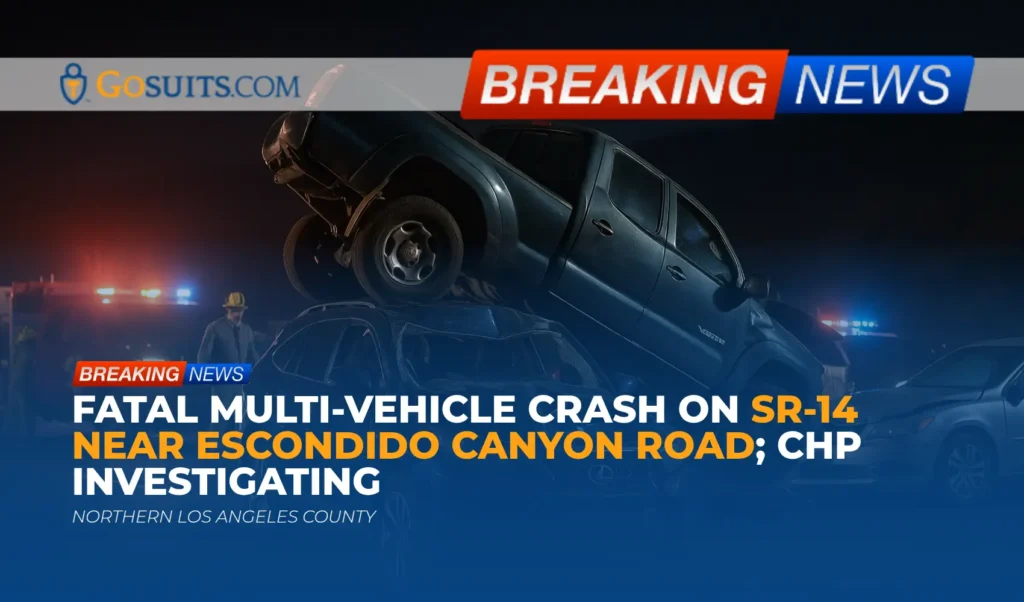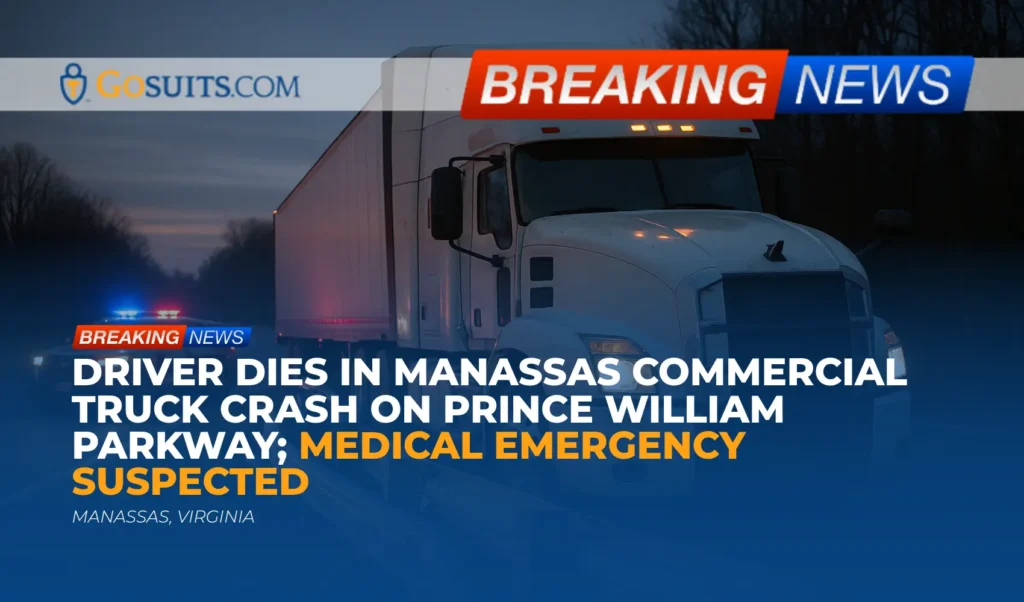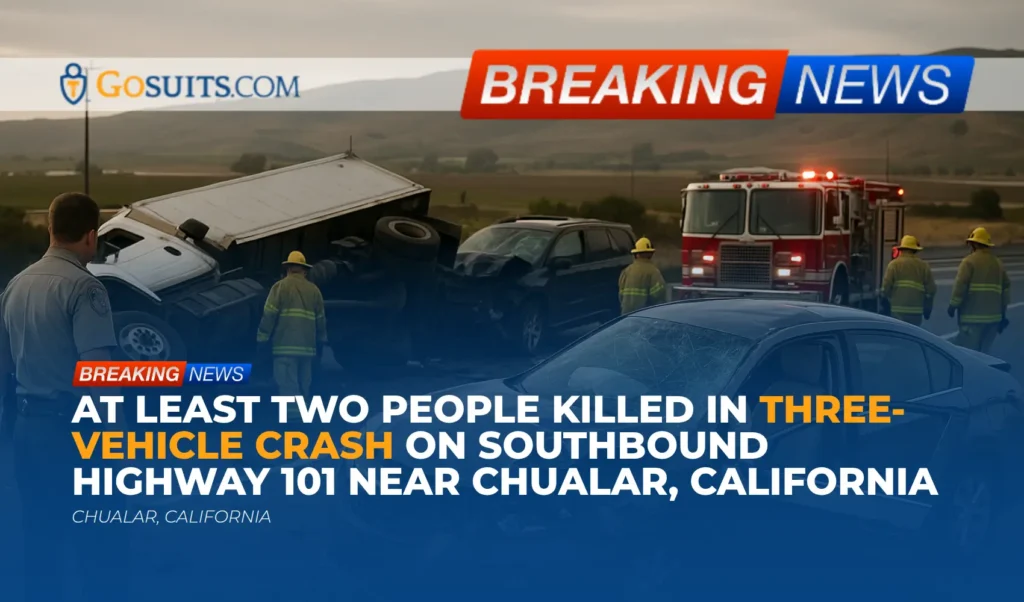- What We Know About the I-27 Four-Vehicle Crash Near Rockwell Road
- When, Where, and Who Was Involved
- Immediate Safety Takeaways for Drivers Stopping on Texas Interstates
- Legal Context in Texas: Duties, Roadside Collisions, and Potential Civil Liability
- Helping at the Scene: Good Samaritan Protections and Safety Measures
- Evidence to Gather and How to Get Official Records
- Medical Attention and Documentation, Even for Seemingly Minor Injuries
- Insurance Considerations and Common Pitfalls After a Multi-Vehicle Crash
- Deadlines and Comparative Responsibility in Texas
- Where to Request Reports and Records for Amarillo-Area Highway Incidents
- Roadway Safety Context: Stopped-Vehicle and Shoulder Incidents
- Commentary from Gosuits Amarillo, Texas Personal Injury Attorney
- Why Timely Action Matters Now
What We Know About the I-27 Four-Vehicle Crash Near Rockwell Road
Authorities reported that a disabled vehicle on the southbound shoulder of Interstate 27 near Rockwell Road in the Amarillo area set the stage for a chain-reaction collision on Friday night. A passing motorist stopped to help. While those vehicles were on the shoulder, a southbound recreational vehicle struck both, leading to a four-vehicle crash. One person was transported to a hospital with injuries described as minor. The crash occurred around 8:45 p.m., and traffic was significantly slowed for more than an hour while responders worked the scene.
Crashes involving stopped or disabled vehicles on high-speed roads are uniquely dangerous. Even when vehicles are on the shoulder, passing traffic may be traveling at interstate speeds, visibility can be limited at night, and a single impact can result in multiple vehicles becoming involved. Incidents like this underline how quickly a good deed or a brief mechanical problem can become a serious safety risk on an interstate shoulder.
When, Where, and Who Was Involved
Based on the initial information from authorities:
- Location: Southbound I-27 near Rockwell Road in the Amarillo area.
- Time: Approximately 8:45 p.m. on a Friday night.
- Vehicles: A disabled vehicle on the shoulder, a motorist who stopped to help, a recreational vehicle traveling southbound that struck the vehicles on the shoulder, and additional vehicles affected in the chain reaction, for a total of four vehicles involved.
- Injuries: One person transported to a hospital with injuries described as minor.
- Traffic impact: Backups of more than an hour while responders managed the scene.
Authorities did not publicly identify the individuals involved. In multi-vehicle scenarios like this, investigating agencies usually document positions of vehicles, skid or yaw marks, lighting and visibility, and statements from drivers and witnesses to determine contributing factors.
Immediate Safety Takeaways for Drivers Stopping on Texas Interstates
Stopping on an interstate shoulder is always hazardous. If you must stop or if you choose to aid another driver, consider these practical steps drawn from general safety guidance contained in the Texas Driver Handbook and common roadway safety practices:
- Get as far onto the shoulder as safely possible: Move the vehicle fully off the travel lane, ideally beyond the fog line, and angle slightly away from traffic.
- Use hazard lights and reflective devices: Turn on flashers immediately. If you have reflective triangles or flares, place them behind your vehicle at increasing distances to warn approaching drivers.
- Consider staying inside with seatbelts fastened: If the shoulder is narrow or traffic is heavy, remaining inside the vehicle with seatbelts on can be safer than standing near live traffic. If you must exit, move well away from the roadway and behind a barrier if available.
- Call for help promptly: Contact 911 to report the situation and request assistance. If available, use roadside assistance through your insurer or vehicle manufacturer after reporting the emergency.
- Do not attempt risky repairs in traffic: Changing a tire or inspecting damage on the traffic-facing side can be dangerous at night. If the vehicle is drivable, consider exiting to the next safe area before stopping.
For general driver safety practices, see the Texas Department of Public Safety’s Texas Driver Handbook, which includes roadway safety considerations for stopped vehicles and emergencies. The handbook is accessible from Texas DPS.
Legal Context in Texas: Duties, Roadside Collisions, and Potential Civil Liability
Texas civil law focuses on whether a driver used ordinary care under the circumstances. Several parts of the Texas Transportation Code often come into play in highway shoulder and chain-reaction crashes. The exact application depends on the facts authorities document.
Core driving duties potentially implicated
- Controlling speed: Drivers must not drive at a speed greater than is reasonable and prudent under existing conditions, considering actual and potential hazards. See Transportation Code 545.351.
- Following distance and avoiding collisions: Texas law requires a driver to maintain a clear and safe distance so they can stop without colliding with the vehicle ahead. See Transportation Code 545.062.
- Move Over Slow Down: Texas law requires slowing down or moving over when approaching certain stationary vehicles displaying visual signals, such as emergency, tow, and TxDOT vehicles. See Transportation Code 545.157. While this statute focuses on protected vehicles with activated signals, the same common-sense caution applies when any vehicle is stopped on the shoulder.
How this can affect civil liability
When a moving vehicle strikes stopped vehicles on the shoulder, investigators look at speed, following distance, visibility, reaction time, and whether the driver acted reasonably for the conditions. Liability may also be influenced by:
- Placement and visibility of the disabled vehicle: Use of hazard lights or reflective devices can matter when assessing whether surrounding drivers had adequate warning.
- Actions of a helping motorist: Stopping to render aid can be protected under Good Samaritan principles, discussed below, but stopping in a manner that creates additional hazard might be examined for reasonableness under the circumstances.
- Chain reaction dynamics: Secondary impacts are often caused by drivers following too closely or not adjusting speed to traffic ahead after an initial collision. Each driver’s conduct is assessed individually.
- Mechanical failure: If a vehicle suffers an unexpected mechanical failure, liability analysis can involve maintenance history or potential product issues. That said, these evaluations are fact-specific and require evidence.
Responsibility in Texas can be shared among multiple parties. The exact apportionment depends on the facts developed by the investigation and any additional evidence such as dashcam video, crash data downloads, or witness statements.
Helping at the Scene: Good Samaritan Protections and Safety Measures
Stopping to help someone in distress is a compassionate act. Texas has a Good Samaritan law that generally limits civil liability for those who in good faith administer emergency care at the scene of an emergency, except for willful or wanton negligence. See Texas Civil Practice and Remedies Code 74.151. While this law focuses on emergency care, it highlights Texas’ public policy of encouraging aid. It does not override basic roadway safety duties. Anyone who stops should prioritize their own safety and that of others by using hazard lights, placing reflective triangles if available, and alerting authorities immediately.
Evidence to Gather and How to Get Official Records
Whether injuries seem minor or major, documentation is essential. In multi-vehicle events, small details often resolve big questions. Consider these steps for preserving information:
- Photographs and video: Capture vehicle positions, damage, license plates, nearby signs, debris fields, skid marks, and lighting conditions. Nighttime lighting and shoulder width matter in reconstructing events.
- Witness contact information: Obtain names and phone numbers of any independent witnesses. Their recollections often fade quickly.
- Crash report: In Texas, when officers investigate crashes with injury, they typically file a crash report. Officers submit these reports under Transportation Code 550.062. Involved parties can usually obtain a copy through the Texas Department of Transportation’s Crash Records Information System.
- Body-worn camera and 911 audio: These can help establish timing and statements. Access may be limited and subject to redaction, but requests can be made under the Texas Public Information Act.
- Medical records: Keep all discharge instructions, imaging reports, and bills. They are essential for documenting injury and treatment.
How to request the Texas crash report
Most Texas crash reports are available through the Texas Department of Transportation’s Crash Records Information System. Involved parties can search and order online. Visit TxDOT CRIS Crash Reports.
Public information requests in Texas
For items like 911 recordings or certain police records, Texas law allows public information requests, with privacy limitations. The Texas Attorney General explains the process and what to expect at Texas Attorney General Open Government.

If a crash involves a fatality
This I-27 incident involved one person with reportedly minor injuries. In crashes resulting in a fatality, next-of-kin may need to communicate with the county medical examiner or the justice of the peace in counties without a medical examiner. Texas law describes inquests and related procedures in Code of Criminal Procedure Chapter 49. For certified death records, see Texas DSHS Vital Statistics. Procedures vary by county, and identification and proof of relationship may be required.
Medical Attention and Documentation, Even for Seemingly Minor Injuries
Many people feel “okay” after a crash, especially adrenaline-fueled moments on an interstate shoulder at night. Soft tissue injuries, mild traumatic brain injuries, or internal strains can emerge hours or days later. Consider taking these steps:
- Get evaluated promptly: A timely medical assessment can identify issues early and create a clear record connecting symptoms to the crash.
- Follow discharge instructions: Keep all paperwork. If symptoms worsen or new symptoms develop, return for care as advised.
- Track time missed and impacts: Note missed work, daily limitations, and activities you can no longer perform comfortably. This documentation can help explain the impact of injuries.
Documenting medical care not only supports health, it also provides clarity for insurance adjusters assessing claims related to the crash.
Insurance Considerations and Common Pitfalls After a Multi-Vehicle Crash
Multi-vehicle collisions can involve several insurance companies and complex questions about who pays for what. Texas consumers have specific rights under state-regulated auto policies. See the Texas Consumer Bill of Rights for Personal Auto Insurance from the Texas Department of Insurance.
Before speaking with any insurer
- Consult an attorney first: A no-cost initial consultation can clarify rights and responsibilities. Statements made to insurers can be recorded and may be used later, sometimes out of context. It is prudent to understand the process before giving any recorded statement.
Common issues in chain-reaction claims
- Multiple adjusters and finger-pointing: Each insurer may point to another driver. Early evidence collection helps prevent delays.
- Property damage and loss-of-use: Texas law often recognizes reasonable repair costs and loss-of-use while a vehicle is down. Keep all estimates and rental receipts.
- Diminished value: After repair, some vehicles lose market value. Whether diminished value is paid depends on the situation and evidence. Document pre-crash condition and mileage.
- Medical payments and PIP: Your own policy may include personal injury protection or medical payments. These can help with immediate costs, regardless of fault, subject to policy limits.
- Uninsured or underinsured motorists: If at-fault coverage is inadequate, your UM or UIM coverage may apply, depending on your policy and the facts.
As claims proceed, keep communication organized. Save emails and letters, and note claim numbers and adjuster contact details. If you choose to speak with insurers, keep statements factual and concise.
Deadlines and Comparative Responsibility in Texas
Texas civil claims are governed by time limits and rules about shared fault.
- Time limits: Many personal injury claims in Texas must be filed within two years of the date of the incident. See Texas Civil Practice and Remedies Code 16.003. Some claims involve shorter deadlines or special notice requirements, especially if a governmental entity is involved in roadway design or maintenance issues. Evaluating deadlines early is important.
- Comparative responsibility: Texas proportionate responsibility rules allow fault to be apportioned among parties. A claimant more than 50 percent responsible may be barred from recovering damages. See Civil Practice and Remedies Code Chapter 33.
Because chain-reaction collisions can include several drivers and evolving accounts, a timely, evidence-based approach is essential to avoid misunderstandings about how the crash unfolded.
Where to Request Reports and Records for Amarillo-Area Highway Incidents
Several agencies can be involved in an interstate crash near Amarillo. Jurisdiction depends on the exact location and responding agency. The following resources can help locate official records:
- Texas crash report: For most reportable crashes, order the official officer’s crash report through TxDOT CRIS Crash Reports. You will need names, date, location details, or the report number if known.
- Local police or sheriff records: If the crash occurred within city limits, the city police department may have related records. If in county jurisdiction, the sheriff’s office or the Texas Department of Public Safety may be the lead. The City of Amarillo provides information and public records request procedures at Amarillo.gov. Public information requests in Texas are governed by the Texas Public Information Act as explained by the Texas Attorney General.
- EMS and fire run reports: Emergency responders may have additional records related to patient contact and scene safety. These may be subject to privacy laws and redactions, but requests can be made through the responding agency’s records division.
- Medical records: Hospitals and clinics have processes for releasing medical records to the patient or authorized representatives. Bring photo identification and any provided patient account numbers.
- If a fatality occurs in a future, separate incident: For autopsy or inquest information, contact the county medical examiner if the county has one, or the justice of the peace performing inquest duties under Chapter 49 of the Code of Criminal Procedure. Certified death records are available through Texas DSHS Vital Statistics.
If it is unclear which law enforcement entity has the report, the TxDOT CRIS system is the most direct statewide resource for crash reports involving injury.
Roadway Safety Context: Stopped-Vehicle and Shoulder Incidents
While this crash resulted in reported minor injuries, collisions involving stopped or disabled vehicles on high-speed highways can have serious outcomes. Drivers approaching shoulder hazards at night may misjudge distance or fail to adjust speed in time. These conditions illustrate why Texas emphasizes speed control and safe following distance in its statutes.
Roadway safety agencies regularly warn drivers about the risks of shoulder activity and the importance of slowing down, keeping distance, and staying alert, especially at night. Texas’ Move Over Slow Down law specifically protects certain vehicles displaying required lights, reflecting a policy of heightened caution around any stationary vehicle on or near the roadway. For the statutory requirement, see Transportation Code 545.157.
National and state transportation safety campaigns consistently recommend hazard lights, reflective devices, and calling for professional assistance rather than attempting repairs on a narrow shoulder in darkness. The Texas Driver Handbook, accessible from Texas DPS, provides general guidance for emergencies that helps reduce risk during roadside stops.
When multiple vehicles are involved in a chain-reaction event, post-crash congestion and secondary collisions become a concern for everyone on the roadway, including first responders and motorists with children in the car. The faster evidence is preserved and vehicles are cleared, the safer the corridor becomes for all road users.

Commentary from Gosuits Amarillo, Texas Personal Injury Attorney
Our thoughts are with everyone affected by the I-27 crash near Rockwell Road. It is unsettling to imagine a simple act of assistance turning into a multi-vehicle collision at night. This discussion is for general information and education. Every situation has unique facts that need careful review.
From a civil injury perspective, a chain-reaction crash on an interstate shoulder raises immediate questions about speed control, following distance, visibility, and warning measures. Investigators often look closely at whether approaching drivers adjusted their speed to match conditions, whether stopped vehicles had hazard lights or other warnings visible to traffic, and how the sequence unfolded. Interstate shoulders are not forgiving places. Even brief inattention, glare, or misjudging the closing speed can result in contact that quickly involves multiple vehicles.
In these situations, insurance carriers often move quickly to shape the narrative. Adjusters may seek recorded statements before people fully understand the facts or have gathered evidence. It is not uncommon for multiple insurers to point fingers at each other, which can slow down medical bill payments or vehicle repairs. Insurers know that most people do not manage multi-car interlocking claims every day, and that uncertainty can result in statements or decisions that affect outcomes later.
A timely, measured approach helps. Preserving photos and video, securing the official crash report, identifying witnesses, and making sure medical evaluation is documented can prevent confusion and delay. Early guidance helps people avoid common pitfalls such as giving broad recorded statements, signing blanket medical authorizations, or accepting early valuations before the full scope of injuries or vehicle damage is understood.
Finally, while not all crashes lead to disputes, multi-vehicle interstate incidents are among the most complex to sort out. A free initial consultation can provide clarity about rights, potential sources of coverage, and practical next steps without creating new risks in the process.
Why Timely Action Matters Now
There are concrete, time-sensitive steps that protect safety, health, and documentation after a multi-vehicle crash:
- Prioritize a medical evaluation: Early care can catch hidden injuries and anchors symptoms to the event. Waiting can complicate recovery timelines and documentation.
- Secure the official crash report: Officer reports often drive insurer decisions. Ordering the report through TxDOT CRIS helps keep claims on track.
- Preserve evidence immediately: Photos, dashcam footage, and witness contacts are easiest to collect in the first days. Over time, vehicles are repaired, scenes change, and memories fade.
- Consult an attorney before speaking with insurers: Initial conversations and recorded statements can shape the claim. Understanding rights first reduces the risk that statements are later used against the claimant.
- Keep organized records: Store medical bills, estimates, repair invoices, and correspondence in one place. Organized documentation shortens claim timelines and reduces disputes.
- Watch for deadlines: Texas law imposes time limits, and some claims have special notice requirements. Knowing the calendar early prevents unintentional forfeiture of rights.
Acting promptly helps ensure safety, preserves key facts, and provides a clearer path through what can otherwise become a complicated, multi-insurer process following a chain-reaction collision on an interstate shoulder.
Sources and references
- Texas Department of Public Safety Texas Driver Handbook
- TxDOT Crash Records Information System Crash Reports
- Texas Transportation Code 545.351 Speed Requirement
- Texas Transportation Code 545.062 Following Distance
- Texas Transportation Code 545.157 Move Over Slow Down
- Texas Transportation Code 550.062 Officers’ Crash Reports
- Texas Civil Practice and Remedies Code 74.151 Good Samaritan
- Texas Civil Practice and Remedies Code 16.003 Limitations Period
- Texas Civil Practice and Remedies Code Chapter 33 Proportionate Responsibility
- Texas Attorney General Public Information Requests
- Texas DSHS Vital Statistics Death Records
- City of Amarillo
- Texas Department of Insurance Consumer Bill of Rights for Personal Auto Insurance






